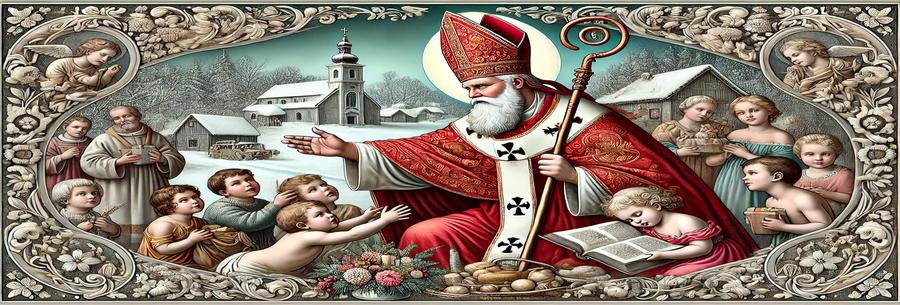St Nicholas is one of the most revered figures in the Christian tradition and has given rise to a multitude of stories and traditions around the world. While his spiritual heritage is rooted in the Christian faith, his influence extends far beyond religion, inspiring the modern-day character of Father Christmas. This article explores the history of Saint Nicholas, his origins, his miracles, his evolution as a cultural symbol, and how he has become a central figure in Christmas celebrations.
Who was Saint Nicholas?
The origins of Nicholas of Myra:
Saint Nicholas was born in the 3rd century in Patare, a town in the region of Lycia, in what is now Turkey. Born into a wealthy Christian family, Nicholas lost his parents at a very young age to an epidemic. Heir to a large fortune, he decided to devote his life to serving God and the poor. Bishop of Myre (today Demre, in Turkey), Nicholas is known for his piety, generosity and zeal in defending the Christian faith. He is said to have taken part in the Council of Nicaea in 325, where he opposed heresies, particularly Arianism.
His death and canonisation:
Saint Nicholas died on 6 December, probably in 343. Quickly venerated, he became one of the most popular saints of Christianity, particularly in the East and West. His relics, transferred to Bari (Italy) in the 11th century, made that city a major place of pilgrimage.
Miracles attributed to Saint Nicholas
Saint Nicholas is often nicknamed the "Thaumaturge" (miracle-worker) because of the many accounts of prodigies attributed to him. These miracles reflect his goodness and his role as protector of the weak and needy.
The legend of the three young girls: one of the most famous stories tells how Nicholas saved three poor young girls from a tragic fate. Their father, unable to provide them with a dowry to marry, planned to sell them into prostitution. Nicholas learned of their plight and secretly deposited bags of gold in their home, enabling them to marry with dignity. This gesture of generosity is the origin of the tradition of anonymous gifts, associated with Saint Nicholas and, later, Father Christmas.
The miracle of the three children: another famous story tells of Saint Nicholas bringing back to life three children who had been killed and salted by a butcher. This miracle makes him the patron saint of children and contributes to his association with childhood and protection.
Protector of sailors and travellers: Saint Nicholas is also known for saving sailors caught in a violent storm. In response to their prayers, he is said to have appeared on their ship to calm the waters. This miracle led to his veneration as the protector of sailors and travellers.
St Nicholas in Christian tradition
St Nicholas Day: the feast of St Nicholas, celebrated on 6 December, is particularly popular in Europe. In France, Belgium, Germany and the Netherlands, children receive gifts or sweets in honour of the saint. This festival often marks the start of the Advent festivities and reflects the generosity and spirit of sharing that characterise Saint Nicholas.
The attributes of Saint Nicholas: he is generally depicted as a bishop, wearing a mitre and a crosier. These attributes are a reminder of his role as a spiritual leader and his commitment to the most disadvantaged. In some regions, he is accompanied by a donkey and a character like the bogeyman, charged with punishing disobedient children.
From Saint Nicholas to Father Christmas: a cultural transformation
The influence of the Netherlands: the Dutch colonists, who brought the figure of Sinterklaas to the United States in the 17th century, were instrumental in the transformation of Saint Nicholas into Father Christmas. Sinterklaas, a Dutch version of Saint Nicholas, was depicted as a generous man visiting children on 6 December.
The evolution in American culture: in the United States, the character of Sinterklaas was gradually transformed into Santa Claus. This change accelerated in the 19th century thanks to literary and artistic works. In 1823, the poem A Visit from St. Nicholas. Nicholas (often called The Night Before Christmas) popularised a jovial image of Santa Claus, handing out presents on Christmas Eve. This cultural transformation was consolidated by Thomas Nast's illustrations and twentieth-century advertising campaigns, notably those for Coca-Cola, which fixed the modern image of Father Christmas: a jolly old man, dressed in red, with a white beard.
A transition from St Nicholas' Day to Christmas: while St Nicholas was celebrated on 6 December, the figure of Father Christmas was moved to 25 December, merging with Christian Christmas traditions. This evolution reflects a cultural adaptation, where the values of generosity and sharing associated with Saint Nicholas were integrated into the celebrations of the Nativity.
The spiritual significance of Saint Nicholas
Despite his transformation into a cultural figure, Saint Nicholas remains a source of spiritual inspiration for Christians.
A model of generosity: Saint Nicholas embodies love of neighbour and Christian charity. His example invites believers to share their blessings with those less fortunate, following Jesus' command, "It is more blessed to give than to receive." (Acts 20:35) A reminder of the true meaning of Christmas: by celebrating St Nicholas, Christians are invited to refocus Christmas on its spiritual meaning: the coming of Jesus Christ, God's ultimate gift to humanity.
St Nicholas, through his stories of miracles and generosity, is much more than just a folk figure. He is a timeless model of faith, charity and service to others. His evolution into Father Christmas reflects the ability of Christian traditions to adapt to cultures, while retaining their spiritual essence.In a world often dominated by consumerism, the example of Saint Nicholas reminds us of the importance of giving with love and celebrating Christmas as a festival of peace, sharing and light.




















